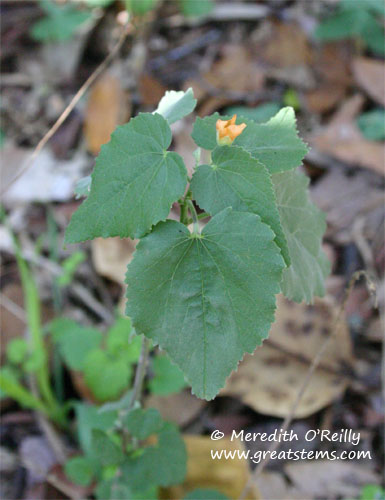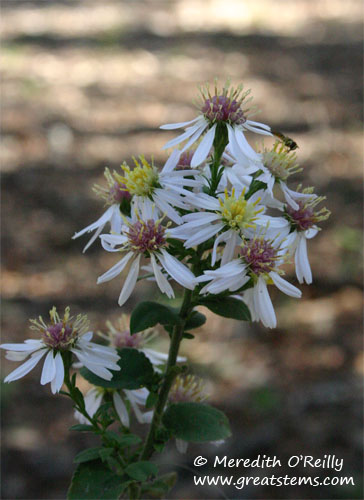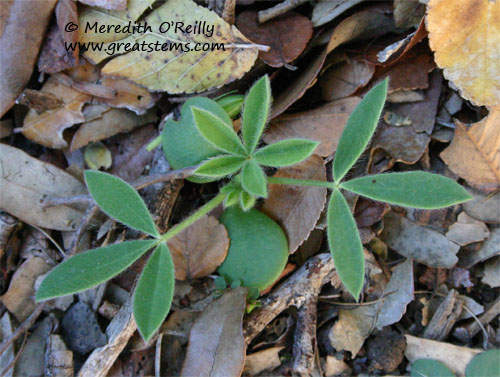Alas, the best of intentions to write a blog post fall short when one gets sick. Without going into detail, let’s just say that I’m thrilled that the O’Reilly Thanksgiving Cold & Cough of 2011 is over (I can’t jinx myself if Thanksgiving 2011 has already passed, right?). But today I’m enjoying the sounds of rain pitter-pattering outside. While we’ll be in a drought for some time to come, I can at least be thankful for the recent rains that are giving a boost to plants’ survival chances.
While wandering the yard this week, I gleefully discovered new natives springing up in various spots.
This is a big advantage to my give-nature-room-to-grow style of gardening!

This Indian Mallow comes with the soft leaves of its type. The leaves are much smaller than those of my Velvet-Leaf Mallow, which get bigger than my hand, but the plant is still young yet. I’ll refrain from IDing it further until it gets a little bigger, because while I want it to be a true Indian Mallow for variety’s sake, it could just be a tiny Velvetleaf working on getting big. That would be fine, too. In any case, I adore these touch-friendly plants. So do skippers and hairstreaks, because guess what — these mallows are caterpillar host plants for them!
 Back in the back, this beautiful aster is showing its colors. It looks like a Texas Aster or a Calico Aster, but its leaves are throwing me off — they just aren’t as elongated as I’d expect. Needless to say, I can’t say for sure what kind of aster it is, just that it IS an aster, of course. Asters are known to interbreed, so perhaps I’ll never really know. In any case, the blooms earn their calico description with white rays and yellow disk flowers that turn purple with age. The hoverflies and native bees love the blooms. Let it spread, let it spread, let it spread.
Back in the back, this beautiful aster is showing its colors. It looks like a Texas Aster or a Calico Aster, but its leaves are throwing me off — they just aren’t as elongated as I’d expect. Needless to say, I can’t say for sure what kind of aster it is, just that it IS an aster, of course. Asters are known to interbreed, so perhaps I’ll never really know. In any case, the blooms earn their calico description with white rays and yellow disk flowers that turn purple with age. The hoverflies and native bees love the blooms. Let it spread, let it spread, let it spread.
Last weekend I spread lots of native Texas seeds around. I had wanted to set up a big germination station this fall, but time didn’t allow it, so I figured they’d at least have a better chance to grow if they were out there in the environment and actually touching DIRT instead of being stuck in my seed container. Some of the many seeds I distributed include: Gayfeather, Antelope Horn, Green Milkweed, Balsam Gourd, Mexican Buckeye, Purple Coneflower, Indian Blanket, Greenthread, Tahoka Daisy, Alamo Vine, Purple PassionflowerVine, Standing Cypress, Red Columbine, Yellow Columbine, Mealy Blue Sage, American Beautyberry, Pigeonberry, Eryngo, Giant Spiderwort, Scarlet Sage, Compass Plant, Lindheimer’s Crownbeard, Lanceleaf Coreopsis, Scarlet Leatherflower, Other Assorted Native Texas Perennials for Fall,and Native Seeds That Shall Remain Nameless Because I Neglected to Write Their Info Down (a.k.a. Mystery Seeds). Oh, and poppy (only non-native).
 A few weeks ago, I had an earlier round of seed-spreading love. This week I noticed a little baby bluebonnet growing. There are other seedlings growing, as well, but they are in the Too-Small-To-Be-Identified Stage.
A few weeks ago, I had an earlier round of seed-spreading love. This week I noticed a little baby bluebonnet growing. There are other seedlings growing, as well, but they are in the Too-Small-To-Be-Identified Stage.
The goal for the day is to make another peanut butter mixture for my bird friends. A cold front will be here this weekend, and I want them to have plenty of fat and protein to help them get through it. I’ve been using Bark Butter, which I also love, but I want something I can spread easily and quickly in the cold, and making it yourself is just more cost effective.
Steady gentle rain still coming down — enjoy the refreshing drink, Mother Earth!
What a hopeful post! You are so fortunate to see things blooming and growing in December! The shot of the Asters is so pretty!
Thanks for reminding me to pick up more birdseed when I go to the store this weekend.
I was wondering , who comes to visit your peanut butter treat. I would like to make some with pine cones but don’t know which birds would visit. Currently we have a mocking bird who polices the whole garden.
Jenny, I have all sorts of birds come to get peanut butter. Nuthatches, wrens, titmice, kinglets, chickadees, and more — it’s very rewarding.
You gave me a reminder for my bird friends, and now I am going to whip up a treat for them. We have a plant up here that looks like your Texas Aster and I have no idea what it is. I have been looking for a match to it with no luck.
One of these days we’ll figure it out, Donna!